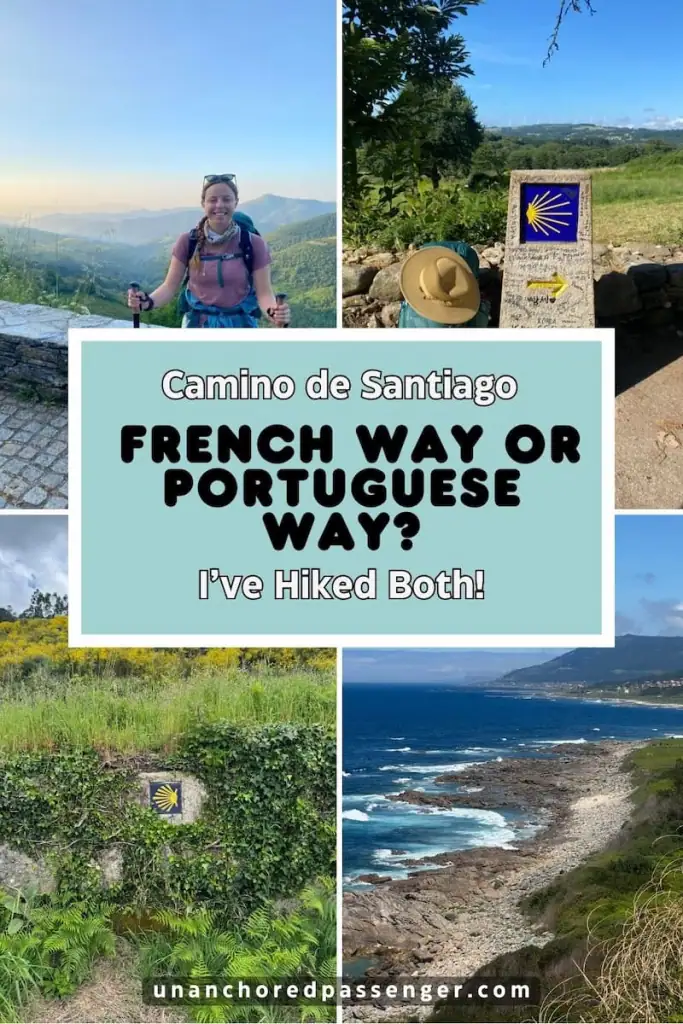Camino Portugués vs. Camino Francés (I Hiked Both Solo)
Are you trying to figure out which Camino de Santiago route is right for you but can't decide between the Camino Portugués vs. Camino Francés? You're not alone. Many folks find themselves torn between the two, especially for their first Camino.
I hiked the Camino Francés in 2023 from Saint-Jean-Pied-de-Port. Then in 2025 I hiked both the Camino Portugués Central and Coastal routes from Porto. There were things I liked better about the French Way and things I liked better about the Portuguese Way.
Every route has something to offer, and it really comes down to your priorities for your hike. Are you looking for a more social experience? Time in the mountains or time on the coast?
There are many factors to consider when choosing between these Camino routes, and I'll walk you through all of them here to help you decide. Let's dive in!

Camino Portugués vs. Camino Francés Map
If you're not familiar with the Camino Portugués and Camino Francés routes, you can get a general sense of where they are in this map.
The Camino Portugués has two main routes that run north to Santiago de Compostela. The Central route technically starts in Lisbon, but the majority of pilgrims start in Porto. The Coastal route starts in Porto before joining the Central route in Redondela, Spain.
The Camino Francés officially starts in Saint-Jean-Pied-de-Port, France just over the border from Spain. From there, pilgrims walk westward across northern Spain to Santiago de Compostela.

At a Glance: Quick Comparison of the Camino Portugués vs. Camino Francés
In my experience, here are the key differences between these Camino de Santiago routes:
- The Camino Portugués routes are much shorter and flatter than the Francés with fewer walking stages on both the Central and Coastal routes.
- Of these routes, the Camino Portugués Coastal is best if you're looking for ocean views and the Francés is best for mountain views.
- There are more stretches along roads and less time in nature on the Portugués routes.
- Infrastructure on both the Francés and Portugués (from Porto) is good, but the Portugués has a little less infrastructure (e.g., places to stay and eat).
- The Portuguese Way offers more choices when it comes to the path you walk whereas the Francés generally has one path to follow.
- While both Caminos are social, the Francés is much more social than the Portugués.
- The Camino Portugués has fewer opportunities for visiting churches and taking part in pilgrim's mass.
Keep reading for more details!
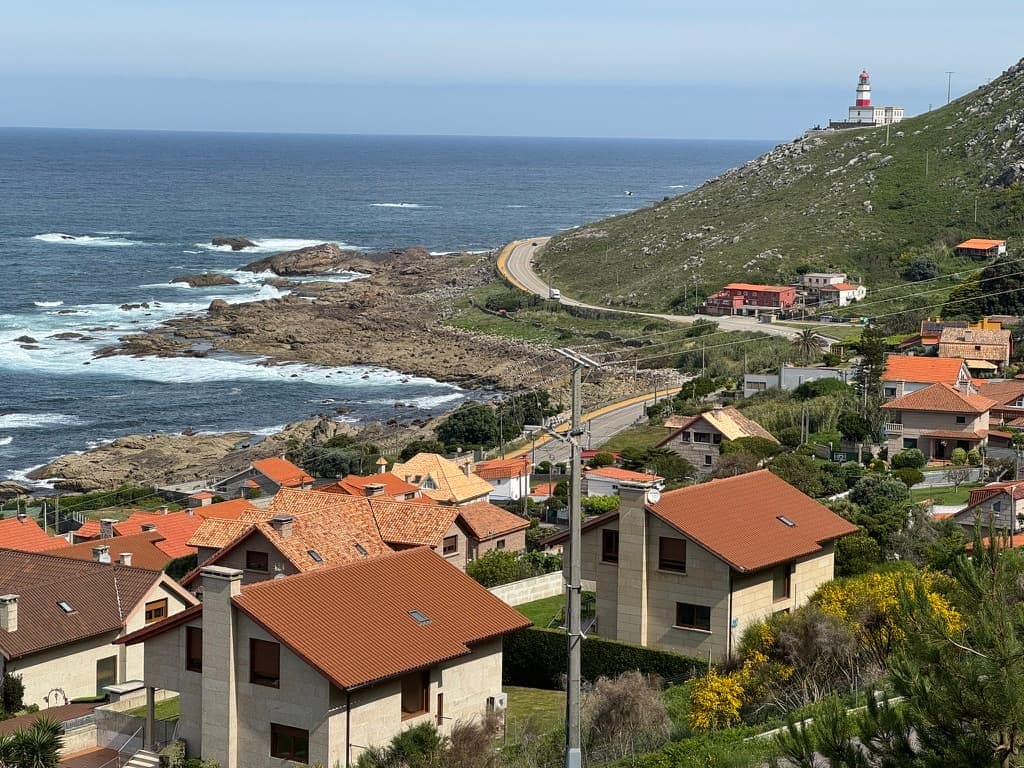
Comparing the Portuguese Way and the French Way
There are loads of factors to consider when choosing your Camino. You'll want to think about practical things like length, difficulty, and infrastructure. You'll also want to make sure you spend some time thinking about the kind of atmosphere you want and what you hope to get out of the Camino.
Are you hoping for a more social experience? A more religious journey? Some time spent alone in reflection?
I'll walk you through all of these factors and more, sharing my firsthand experience on each of these Caminos.

Length
Know that you can really choose any length of route that you want. Many pilgrims choose to start at about 100 km from Santiago. However, when comparing the longer distances that most pilgrims complete on the Camino Francés vs. Portugués, the Francés is about three times longer:
- Camino Francés distance from Saint-Jean-Pied-de-Port: 485 miles (780 km) (typically takes about 30-35 days)
- Camino Portugués distance from Porto:
- Central route: 151 miles (243 km) (typically takes about 10-14 days)
- Coastal route: 170 miles (274 km) (typically takes about 12-15 days)
It's not as popular, but some pilgrims start the Camino Portugués in Lisbon, which is 384 miles (618 km) on the Central and 403 miles (648 km) if you divert to the Coastal route from Porto.
If you have the desire to do a “full Camino” but are worried about committing to a distance as long as the Francés or don't have the time for it, try out one of the Portuguese routes instead. You could use it to test out how you like the experience and could come back for the Francés later.
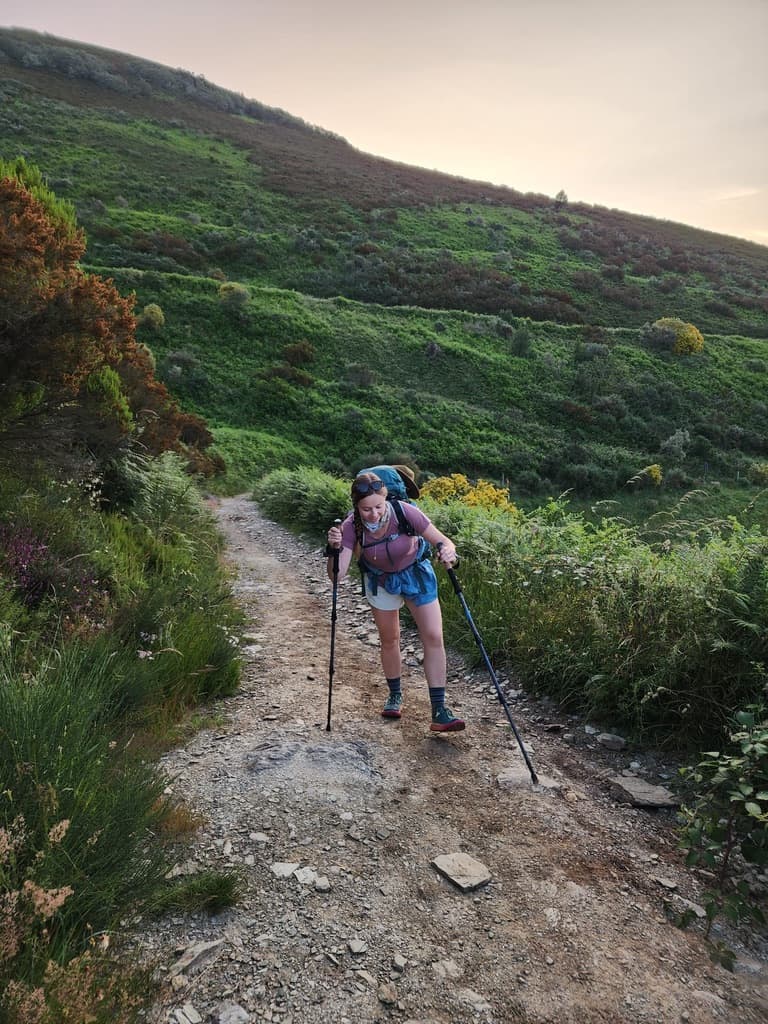
Difficulty
Hikers on the Camino Francés experience more challenging trails than on either Portuguese Camino as you pass through several mountain passes. While the Camino Portugués routes have some elevation gain and loss, it's fairly minimal compared to the Francés.
According to All Trails, here's the total elevation gain for the three routes:
- Camino Francés from Saint-Jean-Pied-de-Port: 64,160 feet (19,556 m)
- Camino Portugués Central from Porto: 17,106 ft (5,214 m)
- Camino Portugués Coastal from Porto: 17,007 ft (5,184 m)
That said, while I personally found the elevation gain and loss on the Francés challenging (but doable), I felt it was SO worth it for the incredible mountain views.
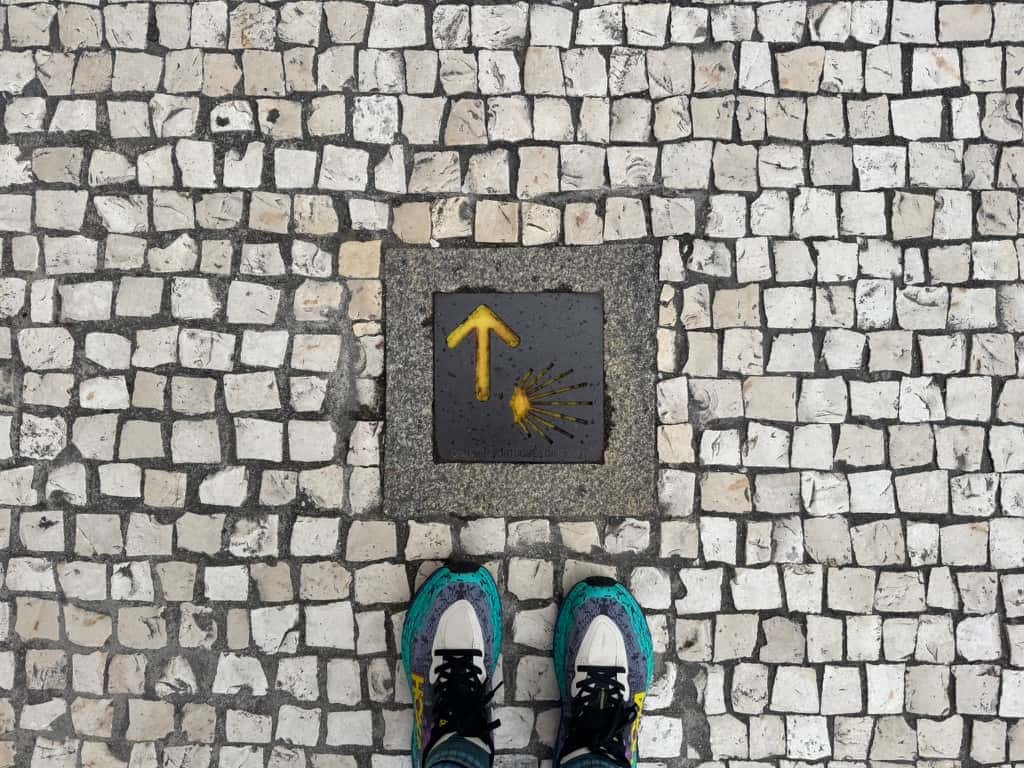
On the flip side, many hikers find the walking surface on the Camino Portugués to be more challenging. Portugal is known for using small, somewhat uneven cobblestones along many of its roads and sidewalks. Walking on these for hours every day isn't exactly pleasant, but it is doable.
The Francés tends to have more crushed gravel and soft dirt paths to walk along. You'll encounter cobblestones from time to time, but they aren't nearly as common. The cobblestones in Spain to be a bit easier on the feet too.
Connect with Other Women Hiking the Camino
Join my free Facebook group! We're building up a community of women who have hiked or are planning to hike the Camino there. You can also get personalized support from me!
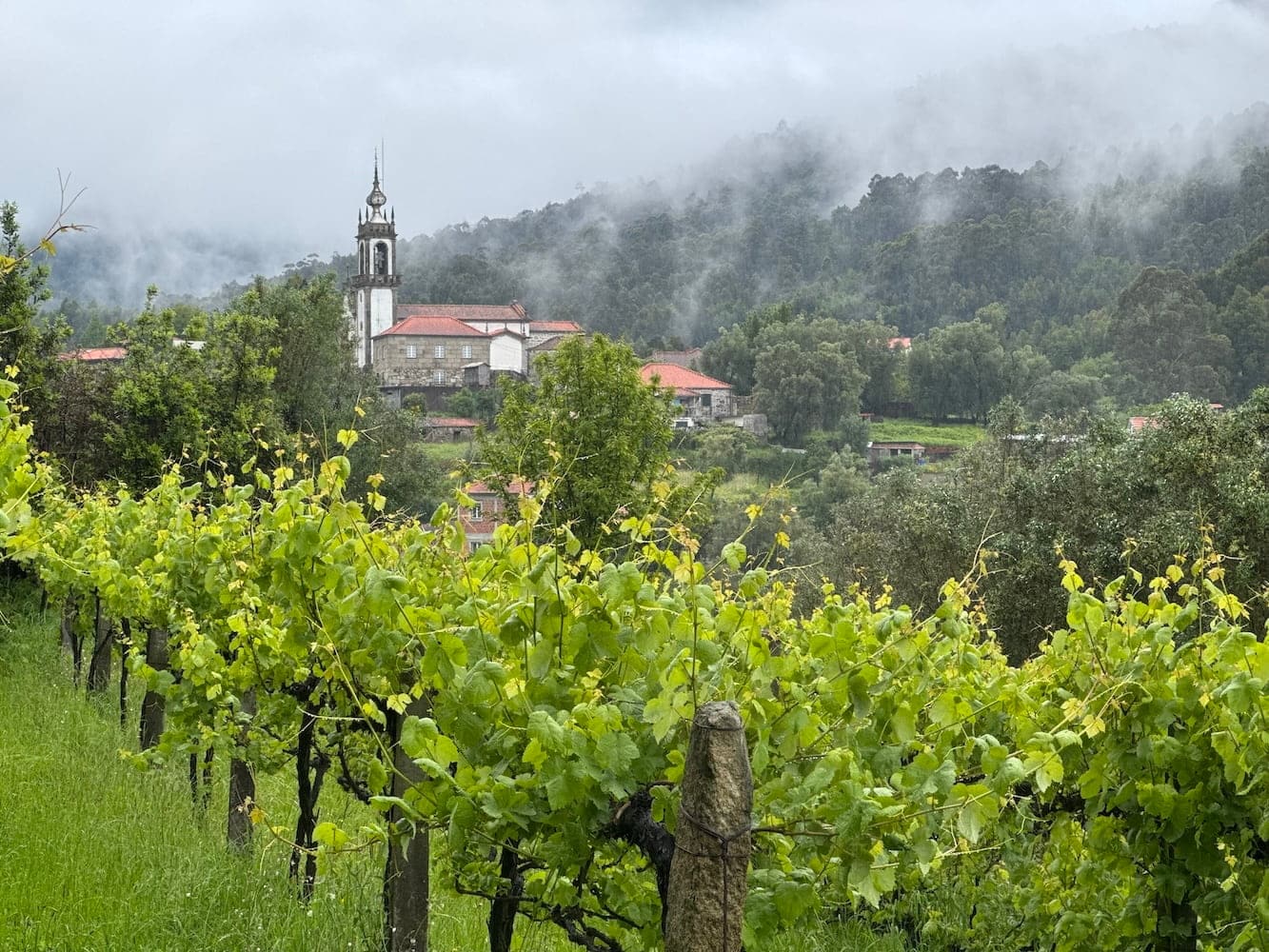
Scenery
The scenery differs quite a bit between the Camino Francés and Portugués routes. Here's what you can generally expect:
- Francés: has a mix of everything with big mountains, vineyards, farmland, flat plains, forests, small villages, and some cities
- Portugués Central: scenery is less varied with small mountains, some vineyards, farmland, forests, small villages, and a few small cities
- Portugués Coastal: you get stunning blue green ocean views, some forests, some small villages but generally more built up cities and industrial areas
I found myself walking less in nature and more along roads on the Camino Portugués compared to the Francés. I still walked through some lovely natural landscapes though. I've heard this is even more true on the Camino Portugués stretch between Lisbon and Porto, with some people reporting sections of road walking that they say feel unsafe.

Infrastructure
Both the Camino Francés and Camino Portugués (from Porto) generally have great infrastructure. For the most part, you can expect to find numerous options for places to stay and cafes and restaurants to stop along the way.
As the oldest most established route, the French Way has a lot more infrastructure set up with larger albergues and more cafes catering to pilgrims.
While the Portuguese Way has decent infrastructure, I found that towns had fewer albergues and the albergues were smaller. However, I often found myself surprised at how nice many albergues were on the Portugués–I suppose because many are much newer than those on the Francés.
Because of the more limited beds available, I found myself booking more on the Portugués whereas on the Camino Francés I did not book ahead often.
The Camino Portugués also had more days with fewer food stops. There were either no places to stop at all or cafes were closed.
Note that I've heard infrastructure on the Camino Portugués is much more limited between Lisbon and Porto and isn't very good.
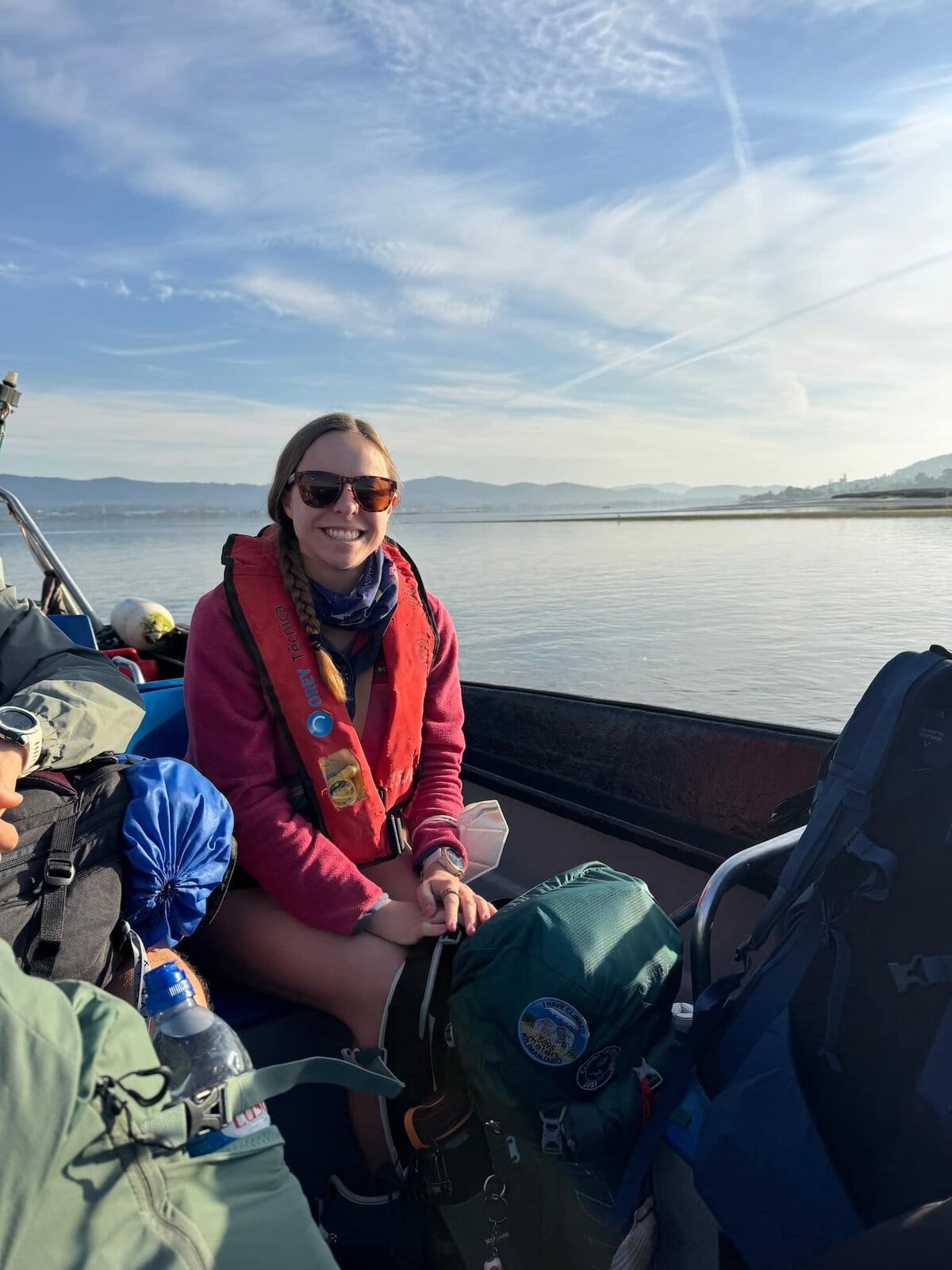
Route Choices
The Camino Francés has a fairly set path with only occasional optional alternate routes. On the other hand, the Camino Portugués has much more flexibility in giving hikers many different options for their walking route.
On the Camino Portugués, you can walk a mix of the Central and Coastal routes if you'd like. There there are multiple points where you can cross from one route to the other.
Along the Coastal route, there are frequent options to walk more inland or more closely along the coast via what's called the Litoral Way. And then as you approach Santiago de Compostela, there's an alternate path via the Spiritual Variant.

Ability to Make Friends
You can make friends from all over the world on both the Camino Portugués and the Francés. I left each of these Caminos having made friends who I still keep in touch with.
The Camino Francés is the most social of all the Camino routes. It's easy to bump into the same people day after day and leave with many friends. Many people say they find their “Camino family” who they hike with every day and spend evenings with.
On the Camino Portugués, you can definitely make friends, but you may not see as many people walking during the day. While I met people on the Camino Portugués, I mostly hiked alone each day and left with far fewer friends. There were plenty of people I met only once or twice and never saw again.

I think it's this way for a few reasons:
- Most people who hike the Francés choose to do it because of the social aspect and are actively seeking it out.
- There are more Camino-oriented experiences like pilgrim's mass and pilgrim's meals along the French Way that make it easier to connect with other pilgrims. I didn't find many of these along the Portuguese Way.
- The Portuguese Way provides multiple different route options you can mix and match. I met many people, for instance, who started on the Coastal before switching to the Central.
- Albergues on the Portuguese Way are smaller, so even if you're staying in the same town as people you've met, you're less likely to bump into them again.
If you want to leave the Camino with a large group of friends and if having a social experience is your top priority, then you should absolutely choose the Camino Francés.
However, if you're looking for more of a mix of alone time and social time, then you might prefer one of the Camino Portugués routes.
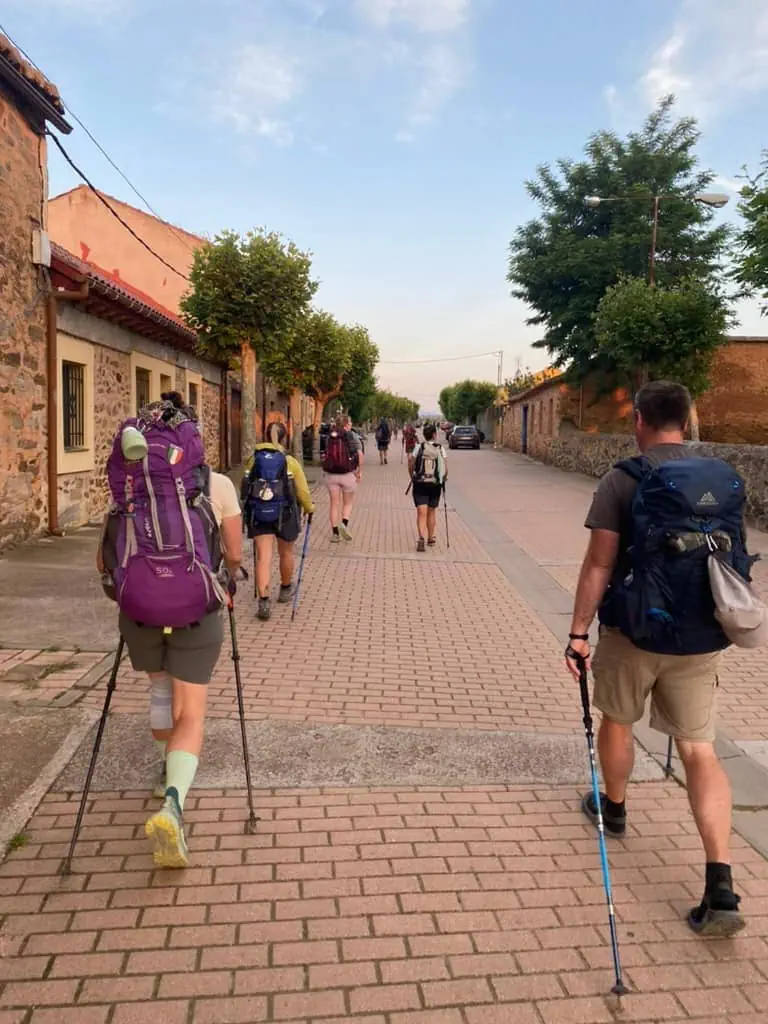
Crowds
Each year the Camino grows in popularity. In 2024, almost half a million people completed one of the Camino de Santiago routes.
The French Way sees the most pilgrims with 236,378 completing that route in 2024 (a 7.54% increase from the year prior. 95,453 pilgrims completed the Camino Portugués Central in 2024 (a 7.58% increase from the year prior). 74,758 pilgrims completed the Camino Portugués Coastal in 2024 (a whopping 41.71% increase from the year prior).
Of all these routes, the stretch from Lisbon to Porto along the Camino Portugués sees the fewest pilgrims. Only 3,142 pilgrims who completed the Camino in 2024 started in Lisbon.
The busiest part of any Camino is always the last 100 km before Santiago de Compostela. Before that, you'll definitely encounter people on the trail but less so.

These statistics line up with my own experience. When I hiked the Camino Francés in June 2023, I often saw a line of pilgrims in front and behind me whereas the Camino Portugués routes that I hiked in May 2025 felt much quieter.
That said, on all of the routes there were times when I didn't see anyone around me, and there are ways to avoid crowds on any route if that's what you desire. Many people complain about how crowded the last 100 km of the Camino Francés can be, but that wasn't my experience at all because I stayed “off stage,” avoiding staying in towns recommended by guidebooks.
You can access my Camino Francés itinerary below and see where I stayed for the last 100 km.
On the Camino Portugués, you can easily avoid crowds for most of the last 100 km by taking the Spiritual Variant.
Safety
These Camino de Santiago routes are so popular that they're generally very safe, even as a woman hiking solo. That's not to say incidents don't happen–with so many people hiking, things do happen.
I was admittedly a little nervous before my hikes on the Camino Portugués because I had heard some reports of women encountering creepy men trying to follow them in a few locations along the trail. I've seen reports of this on the Francés as well but they seem to be less common for that route.
On all of these trails, there were always enough people around that I felt safe and thankfully didn't have any issues. The biggest risk on any Camino is usually pet theft. Violent crimes are not common.

Cost
Cost doesn't vary wildly between the Camino Francés and Camino Portugués. However, in my experience, there seem to be more beds in municipal albergues along the way and more pilgrim's menus with dinner deals along the Camino Francés.
With that in mind, the Camino Portugués is likely slightly more expensive for many pilgrims.
For either Camino, I would budget about 50 euros per day to be safe if you plan to stay in albergues, but you may be able to spend less. If you plan to stay in private rooms, you'll want to budget more.

Weather
Along the Camino Francés, you'll need to be prepared for all kinds of weather. You can experience cold weather conditions and sometimes even snow along some of the mountain passes on the route. At the same time, you need to be prepared for hot sunny weather along the Meseta that runs from about Burgos to León.
With more extremes in weather, there is more of a limited window of time for hiking the Camino Francés, especially if you want to experience the mountain portions of the route.
Weather along the Camino Portugués tends to be milder throughout the year with less extremes in temperature. Northern Portugal and Galicia are known for being quite rainy though, so keep that in mind.
Sign up to get this spreadsheet that has more information on weather by month for each route:

History
While the Camino Francés was not the first Camino route, it has been the most popular of all the routes since the 11th century.
While the Camino Portugués didn't become popular for modern pilgrims until around 15 years ago, it's been around for about a century and has historical importance as well. The parents of Portugal's first king completed the Camino Portugués in 1097, and Queen Isabel walked it as well in 1325 and 1335.
The Spiritual Variant option along the Camino Portugués is arguably the most historic stretch of any Camino route. As part of the Spiritual Variant, pilgrims take a boat ride from Vilanova de Arousa to just outside of Padrón, following the path that the body of Saint James was allegedly brought into Galicia.

Religion
As the only Christian pilgrimage in the world with a UNESCO World Heritage designation, the Camino de Santiago has plenty of opportunities for embracing religion and having a spiritual experience. However, I was surprised with the more limited opportunities on the Camino Portugués.
If you're hiking for religious reasons, then the Francés is likely the best route for you.
When I hiked the Camino Francés, many stops along the way had churches open for visiting and the opportunity to partake in pilgrim's mass. I even stayed at an albergue run by singing nuns.
On the Camino Portugués, I only had the opportunity to join a pilgrim's mass or blessing a few times. It also seemed that most churches on the Portugués Central route were closed.

Tips to Choose Between the Camino Portugués vs. Francés
Still stuck between the routes? Here are a few tips that might help. You can also find more tips here.
- Think about what you want to get most out of your Camino and your reasons for walking. It might help to assign a rating to each criteria and rank them in order of priority–you can do this using the spreadsheet linked below.
- Consider the amount of time you have available and know that you can start anywhere you want that fits your schedule.
- Ask yourself if you'd prefer to spend more time in Spain or in a mix of Spain and Portugal.
- Know that you could hike both! Many people get hooked after their first Camino and return to hike more routes.
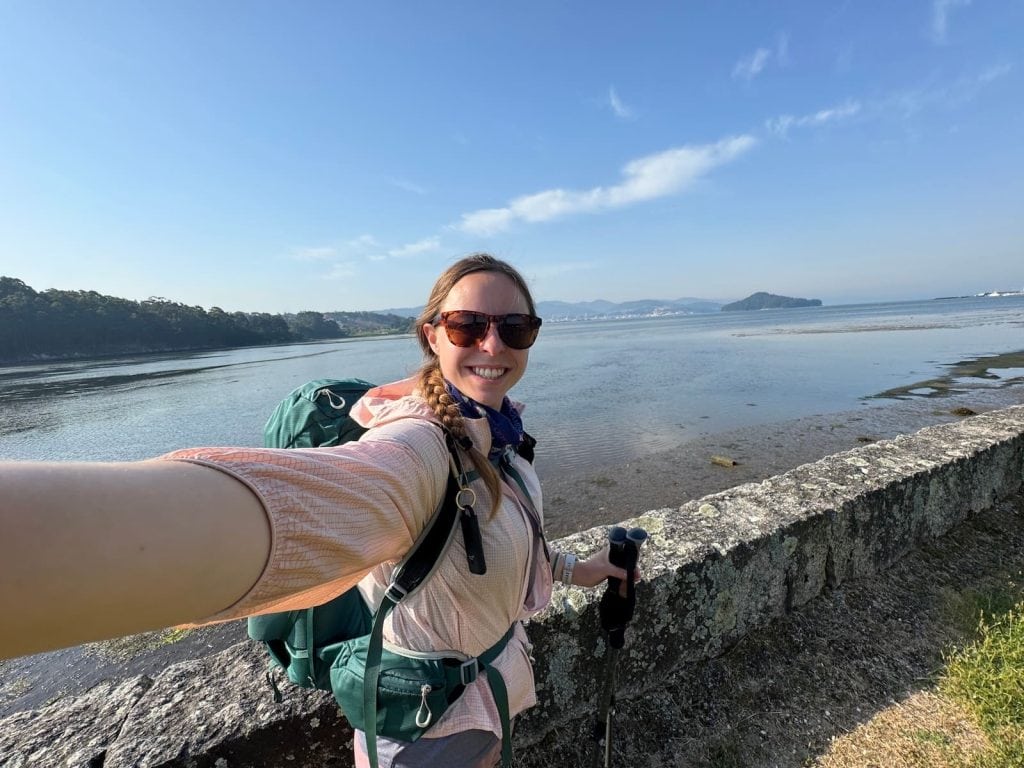
My Experience on the Camino Francés and Camino Portugués
I loved my experiences on the Francés, Portugués Central, and Portugués Coastal routes. While they are quite similar in many ways, they have their differences too.
I'll be honest that I felt a little disappointed in the Portugués Central route and others I met who had done the Francés told me they felt the same. I think I expected it to be too much like the Francés, which was my issue.
I had always read that the Camino Portugués Central route is the more traditional of the two routes in Portugal, so I think that's why I figured it would be similar enough to the Francés.
Instead, I was disappointed to meet fewer people than I expected while hiking, less infrastructure, and not as much of a general spirit of the Camino. In the end, it was still a great experience and I recommend it to anyone, but don't expect it to be just like the Francés.
On the other hand, I had very different expectations for the Camino Portugués Coastal route. I had heard it wasn't as Camino oriented and that it would be harder to make friends, so I went into it with my only expectation being that I'd see lovely coastal views.
I felt pleasantly surprised though. With the route growing so much, I found that I met many more people on the Coastal route. The views were stunning, and I even felt like I found a little more of the Camino spirit on that hike compared to the Central because there seemed to be more opportunities for visiting churches, going to pilgrim's mass, and having pilgrim's meals together.

Frequently Asked Questions
Let's dive into some frequently asked questions when it comes to comparing these notable Camino routes.
Which Camino is best for the first time?
Either the Camino Francés or Camino Portugués are great for first time pilgrims with a solid infrastructure in place, historic significance, and opportunities to meet people from all over the world. The Camino Francés has been the most popular route since the 11th century and arguably has the strongest Camino spirit of all the routes. If you think you'll only do one Camino, then I suggest the Francés.
What is the most popular Camino?
The Camino Francés is the most popular Camino route. Almost half of pilgrims in 2024 completed the Camino Francés.
The Camino Portugués routes are the next most popular. About 20% completed the Portugués Central and 15% completed the Portugués Coastal in 2024.
Is the Portuguese Camino worth it?
The Camino Portugués is absolutely worth it depending on what you're looking to get out of the experience. If you're expecting it to be exactly the same as the Camino Francés, you may disappointed.
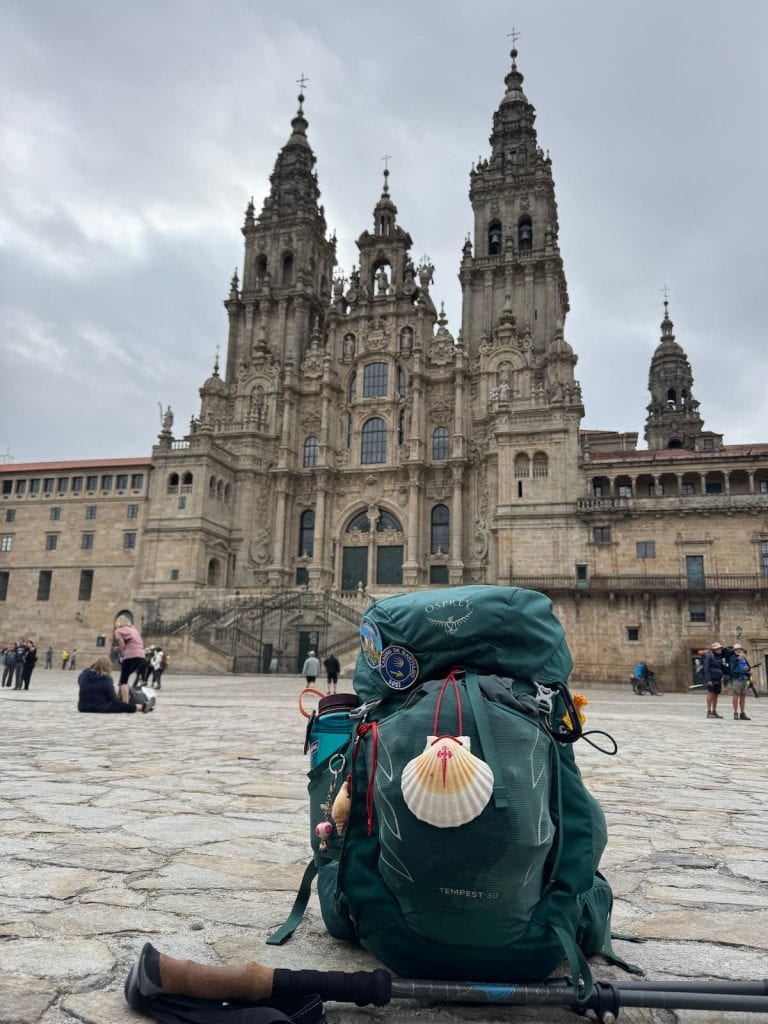
Conclusion: Which Camino Route is Best for You?
Now you know how the Camino Portugués and Camino Francés differ when it comes to things like difficulty, ability to make friends, religious experience, and more. I hope you found this helpful as you're trying to decide which route is best for you.
I truly believe every Camino route has something to offer, and no matter which you decide, I'm confident you'll have a wonderful adventure.
If you still have questions, I encourage you to join my women's Facebook group and check out some of my articles below.
Connect with Other Women Hiking the Camino
Join my free Facebook group! We're building up a community of women who have hiked or are planning to hike the Camino there. You can also get personalized support from me!


